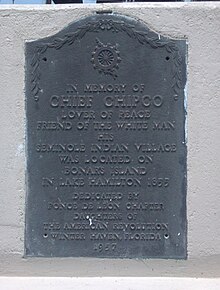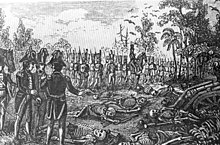
The Muscogee, also known as the Mvskoke, Muscogee Creek or just Creek, and the Muscogee Creek Confederacy, are a group of related Indigenous peoples of the Southeastern Woodlands in the United States. Their historical homelands are in what now comprises southern Tennessee, much of Alabama, western Georgia and parts of northern Florida.

The Seminole Wars were a series of three military conflicts between the United States and the Seminoles that took place in Florida between about 1816 and 1858. The Seminoles are a Native American nation which coalesced in northern Florida during the early 1700s, when the territory was still a Spanish colonial possession. Tensions grew between the Seminoles and settlers in the newly independent United States in the early 1800s, mainly because enslaved people regularly fled from Georgia into Spanish Florida, prompting slaveowners to conduct slave raids across the border. A series of cross-border skirmishes escalated into the First Seminole War in 1817, when American General Andrew Jackson led an incursion into the territory over Spanish objections. Jackson's forces destroyed several Seminole and Black Seminole towns, as well as the briefly occupied Pensacola before withdrawing in 1818. The U.S. and Spain soon negotiated the transfer of the territory with the Adams-Onis Treaty of 1819.

The Seminole are a Native American people who developed in Florida in the 18th century. Today, they live in Oklahoma and Florida, and comprise three federally recognized tribes: the Seminole Nation of Oklahoma, the Seminole Tribe of Florida, and the Miccosukee Tribe of Indians of Florida, as well as independent groups. The Seminole people emerged in a process of ethnogenesis from various Native American groups who settled in Spanish Florida beginning in the early 1700s, most significantly northern Muscogee Creeks from what are now Georgia and Alabama.

Osceola, named Billy Powell at birth in Alabama, became an influential leader of the Seminole people in Florida. His mother was Muscogee, and his great-grandfather was a Scotsman, James McQueen. He was reared by his mother in the Creek (Muscogee) tradition. When he was a child, they migrated to Florida with other Red Stick refugees, led by a relative, Peter McQueen, after their group's defeat in 1814 in the Creek Wars. There they became part of what was known as the Seminole people.

The Second Seminole War, also known as the Florida War, was a conflict from 1835 to 1842 in Florida between the United States and groups of people collectively known as Seminoles, consisting of American Indians and Black Indians. It was part of a series of conflicts called the Seminole Wars. The Second Seminole War, often referred to as the Seminole War, is regarded as "the longest and most costly of the Indian conflicts of the United States". After the Treaty of Payne's Landing in 1832 that called for the Seminole's removal from Florida, tensions rose until fierce hostilities occurred in the Dade battle in 1835. This conflict started the war. The Seminoles and the U.S. forces engaged in mostly small engagements for more than six years. By 1842, only a few hundred native peoples remained in Florida. Although no peace treaty was ever signed, the war was declared over on August 14, 1842.

The Creek War was a regional conflict between opposing Native American factions, European powers, and the United States during the early 19th century. The Creek War began as a conflict within the tribes of the Muscogee, but the United States quickly became involved. British traders and Spanish colonial officials in Florida supplied the Red Sticks with weapons and equipment due to their shared interest in preventing the expansion of the United States into regions under their control.
Red Sticks —the name deriving from the red-painted war clubs of some Native American Creek—refers to an early 19th century traditionalist faction of Muscogee Creek people in the Southeastern United States. Made up mostly of Creek of the Upper Towns that supported traditional leadership and culture, as well as the preservation of communal land for cultivation and hunting, the Red Sticks arose at a time of increasing pressure on Creek territory by European American settlers. Creek of the Lower Towns were closer to the settlers, had more mixed-race families, and had already been forced to make land cessions to the Americans. In this context, the Red Sticks led a resistance movement against European American encroachment and assimilation, tensions that culminated in the outbreak of the Creek War in 1813. Initially a civil war among the Creek, the conflict drew in United States state forces while the nation was already engaged in the War of 1812 against the British.
Peter McQueen was a chief, prophet, trader and warrior from Talisi He was one of the young men known as Red Sticks, who became a prophet for expulsion of the European Americans from Creek territory and a revival of traditional practices. The Red Sticks attracted a majority of the population in the Upper Towns in the early nineteenth century. From open conflict with the Lower Towns in the Creek War, the Red Sticks were drawn into conflict with the United States after being attacked by territorial militia.

The Miccosukee Tribe of Indians is a federally recognized Native American tribe in the U.S. state of Florida. Together with the Seminole Nation of Oklahoma and the Seminole Tribe of Florida, it is one of three federally recognized Seminole entities.

Wild Cat, also known as Coacoochee or Cowacoochee (from Creek Kowakkuce "bobcat, wildcat") (c. 1807/1810–1857) was a leading Seminole chieftain during the later stages of the Second Seminole War and the nephew of Micanopy.
The Treaty of Payne's Landing was an agreement signed on 9 May 1832 between the government of the United States and several chiefs of the Seminole Indians in the Territory of Florida, before it acquired statehood.

The Dade battle was an 1835 military defeat for the United States Army. The U.S. was attempting to force the Seminoles to move away from their land in Florida and relocate to Indian Territory. Amidst a war between the Government of the United States and the Seminole two U.S. Army companies numbering 103 men under the command of Major Francis L. Dade were ambushed by approximately 180 Seminole warriors as they marched from Fort Brooke on Tampa Bay to reinforce Fort King in Ocala. Only three U.S. soldiers survived the attack, and one died of his wounds the following day.
Ahaya was the first recorded chief of the Alachua band of the Seminole tribe. European-Americans called him Cowkeeper, as he held a very large herd of cattle. Ahaya was the chief of a town of Oconee people near the Chattahoochee River. Around 1750 he led his people into Florida where they settled around Payne's Prairie, part of what the Spanish called tierras de la chua, "Alachua Country" in English. The Spanish called Ahaya's people cimarones, which eventually became "Seminoles" in English. Ahaya fought the Spanish, and sought friendship with the British, allying with them after Spain ceded Florida to Great Britain in 1763, and staying loyal to them through the American Revolutionary War. He died shortly after Britain returned Florida to Spain in 1783.
Uchee Billy or Yuchi Billy was a chief of a Yuchi band in Florida during the first half of the 19th century. Uchee Billy's band was living near Lake Miccosukee when Andrew Jackson invaded Spanish Florida during the First Seminole War and attacked the villages in the area. Yuchi Billy and his band then moved to the St. Johns River. During the Second Seminole War, Uchee Billy was an ally of the Seminoles, and was one of the principal war chiefs who fought the U.S. Army.
David Moniac, an American military officer, was the first Native American graduate of the United States Military Academy at West Point, New York in 1822. A Creek with some Scots ancestry, who was related to major Creek leaders on both sides of his family, Moniac was the first cadet to enter West Point from the new state of Alabama. Moniac resigned his commission in 1822 to manage his clan's property in Alabama, where he developed a cotton plantation.
Wahoo is an unincorporated community in Sumter County, Florida, United States. First settled by the Timucua, the area was eventually settled by the Seminoles. During the Second Seminole War, Wahoo and the surrounding area served as shelter to the Seminoles and as the site of several skirmishes. After the war, white settlers migrated to the area and established a thriving town.

Neamathla (1750s–1841) was a leader of the Red Stick Creek. His name, in the Hitchiti language, means "fat next to warrior", "fat" being a reference to great courage. The Hitchiti language had no written form, but modern scholars agree that Eneah Emathla is the "proper" spelling of his name in English; however, there were two other men also named Eneah Emathla, so the modern convention is to use the spelling Neamathla for the leader.

Fort Basinger's original site is located approximately 35 miles (56 km) west of Fort Pierce, Florida, along U. S. Highway 98 in Highlands County, Florida. It was a stockaded fortification with two blockhouses that was built in 1837 by the United States Army. It was one of the military outposts created during the Second Seminole War to assist Colonel Zachary Taylor's troops to confront and capture Seminole Indians and their allies in the central part of the Florida Territory in the Lake Okeechobee region. The Seminole Indians and their allies were resisting forced removal to federal territory west of the Mississippi River as directed by the Indian Removal Act.
Gad Humphreys was an officer in the United States Army and an Indian agent in Florida. He was appointed to his post in 1822. He was supportive of the Indians and tried to help them and protect them from encroachments by White settlers. He was accused of abusing his post by preventing or delaying the return to their owners of fugitive slaves that had taken refuge with the Indians. An investigation was conducted, but none of his accusers were willing to testify. Even so, he was removed from his post in 1830.
Fishing ranchos were fishing stations located along the coast of Southwest Florida used by Spanish Cuban fishermen in the late 18th and early 19th centuries. The Spanish fished the waters along the coast of Florida in the late fall and winter of each year, salting the fish, and then carrying the cured fish to Havana by the beginning of Lent. The Spanish fishermen hired Native Americans who lived along the coast as guides and to help with catching and curing the fish, and with sailing to Havana. The Spanish established fishing stations, called "ranchos", on islands along the coast as bases during the fishing season. The Native American workers lived year-round at the ranchos, or moved to the nearby mainland during the off-season to hunt and raise crops. Many of the Spanish fishermen eventually started living at their ranchos year-round. They married or formed relationships with Native American women, and their children grew up at the ranchos, so that many of the workers were mixed of Spanish and Native American descent. All of the residents of the ranchos spoke Spanish. One author has suggested that a Spanish-Native American creole society was forming in the ranchos by the second quarter of the 19th century. The fishermen also carried Native Americans from Florida to Havana and back on a regular basis.













